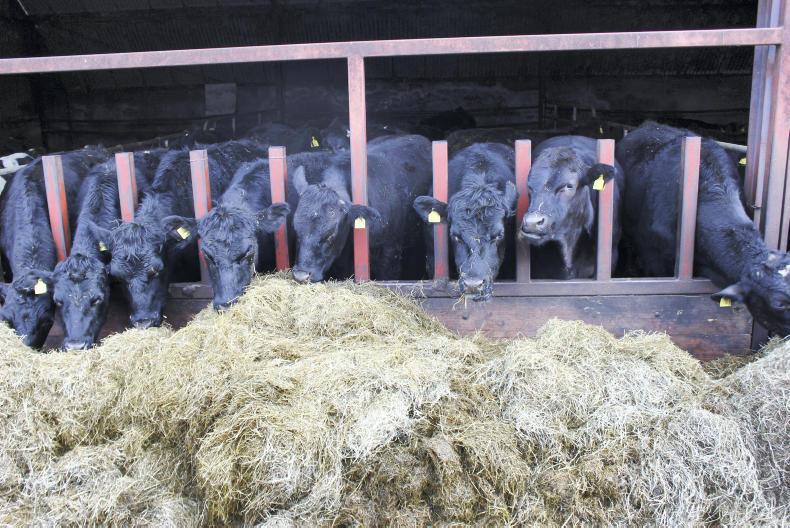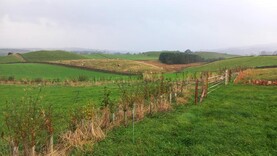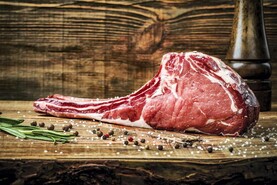After decades of buying strong, continental types for fattening, I have finally changed direction and am now the proud owner of some black bullocks.
There were numerous reasons for moving to a different type of animal, although the primary one was my desire to have no nervous or flighty stock in my care.
There isn’t much point in complaining about the problems that wild cattle cause on a farm where help is limited, if I simply go out and buy another load of continental steers year after year.
Starting to contract-rear dairy heifers has also proven to be a catalyst in my decision. The pleasures of handling, shifting, or loading extremely quiet cattle merely served as a prompt that I ought to move away from those more nervous types.
In truth, I had forgotten that carrying out routine veterinary jobs involving cattle could be so stress-free. Instead of lining up a row of steers in the crush and praying they wouldn’t injure either themselves or (more importantly) me, I could fill up the race with dairy heifers and go away for my lunch if I so desired.
Out-of-spec beef
I have also been aware for years now that I am guilty of producing out-of-spec beef. Storing cattle over winter, then finishing them off grass with a lick of meal ticks a lot of boxes, mostly in terms of a customer-friendly image.
But it does not produce a U-grading Charolais or Limousin bullock at under 400kg carcase weight, unless you like your meat totally fat-free. Too many well-bred animals, originating in the suckler herd, are designed to be finished at very heavy weights (over 750kg liveweight) and my system was coming under increasing pressure to drive a square peg into a round hole. It just didn’t fit. Aberdeen Angus bullocks seem ideal on several fronts. Possibly quieter (especially if hand-reared), probably more suited to finishing off grass without the need for much meal feeding, quite likely to fit the weight specification for supermarkets, and with a ready market for Angus beef (I wonder how long before that bubble bursts) all that remained was to waltz into a store sale in the month of February and buy 20 of them for half nothing.
Purchase
Strangely enough, other people also seemed quite keen to purchase this type of animal, and I ended up with a batch (out of two sales) that averaged 467kg costing £972 (208p/kg liveweight). Quality is far more varied than I am used to, with some shapely animals standing side by side with plain cattle. This is reflected in the price, with two bullocks of the same weight showing a difference of £140 in buying price.
Nevertheless, I am as pleased as punch with my purchases; when I walk into the slatted pen they really can’t be bothered moving out of my way.
Another positive sign is how many of them are quite content to have my hand running along their backs without the desire to clear a five-bar gate into the next pen. At this stage all I can say is: so far, so good.
Silage stocks
It is possibly worth mentioning the reason for buying cattle at the “wrong” time of year. After last summer’s drought, I had limited silage stocks.
Also with a degree of uncertainty surrounding the actual date that 30 in-calf heifers were leaving these premises, I thought it would be more prudent to wait until the dairy cattle had gone, then assess how much silage was left.
Despite the heifers leaving here just before the new year, I hadn’t enough silage to immediately replace them with store cattle.
Therefore, we waited until February/March, despite knowing full well that the world and his wife would be looking for something to graze grass at that time of year.
Of course, the bottom line is that it is hard to envisage much genuine profit from buying these cattle. But then again, I can’t remember the last time beef cattle made a meaningful contribution to net margins on this farm anyway.
Read more
Life and death in the ovine world
Farmer Writes: contract-rearing: so far so good
After decades of buying strong, continental types for fattening, I have finally changed direction and am now the proud owner of some black bullocks.
There were numerous reasons for moving to a different type of animal, although the primary one was my desire to have no nervous or flighty stock in my care.
There isn’t much point in complaining about the problems that wild cattle cause on a farm where help is limited, if I simply go out and buy another load of continental steers year after year.
Starting to contract-rear dairy heifers has also proven to be a catalyst in my decision. The pleasures of handling, shifting, or loading extremely quiet cattle merely served as a prompt that I ought to move away from those more nervous types.
In truth, I had forgotten that carrying out routine veterinary jobs involving cattle could be so stress-free. Instead of lining up a row of steers in the crush and praying they wouldn’t injure either themselves or (more importantly) me, I could fill up the race with dairy heifers and go away for my lunch if I so desired.
Out-of-spec beef
I have also been aware for years now that I am guilty of producing out-of-spec beef. Storing cattle over winter, then finishing them off grass with a lick of meal ticks a lot of boxes, mostly in terms of a customer-friendly image.
But it does not produce a U-grading Charolais or Limousin bullock at under 400kg carcase weight, unless you like your meat totally fat-free. Too many well-bred animals, originating in the suckler herd, are designed to be finished at very heavy weights (over 750kg liveweight) and my system was coming under increasing pressure to drive a square peg into a round hole. It just didn’t fit. Aberdeen Angus bullocks seem ideal on several fronts. Possibly quieter (especially if hand-reared), probably more suited to finishing off grass without the need for much meal feeding, quite likely to fit the weight specification for supermarkets, and with a ready market for Angus beef (I wonder how long before that bubble bursts) all that remained was to waltz into a store sale in the month of February and buy 20 of them for half nothing.
Purchase
Strangely enough, other people also seemed quite keen to purchase this type of animal, and I ended up with a batch (out of two sales) that averaged 467kg costing £972 (208p/kg liveweight). Quality is far more varied than I am used to, with some shapely animals standing side by side with plain cattle. This is reflected in the price, with two bullocks of the same weight showing a difference of £140 in buying price.
Nevertheless, I am as pleased as punch with my purchases; when I walk into the slatted pen they really can’t be bothered moving out of my way.
Another positive sign is how many of them are quite content to have my hand running along their backs without the desire to clear a five-bar gate into the next pen. At this stage all I can say is: so far, so good.
Silage stocks
It is possibly worth mentioning the reason for buying cattle at the “wrong” time of year. After last summer’s drought, I had limited silage stocks.
Also with a degree of uncertainty surrounding the actual date that 30 in-calf heifers were leaving these premises, I thought it would be more prudent to wait until the dairy cattle had gone, then assess how much silage was left.
Despite the heifers leaving here just before the new year, I hadn’t enough silage to immediately replace them with store cattle.
Therefore, we waited until February/March, despite knowing full well that the world and his wife would be looking for something to graze grass at that time of year.
Of course, the bottom line is that it is hard to envisage much genuine profit from buying these cattle. But then again, I can’t remember the last time beef cattle made a meaningful contribution to net margins on this farm anyway.
Read more
Life and death in the ovine world
Farmer Writes: contract-rearing: so far so good






 This is a subscriber-only article
This is a subscriber-only article










SHARING OPTIONS: